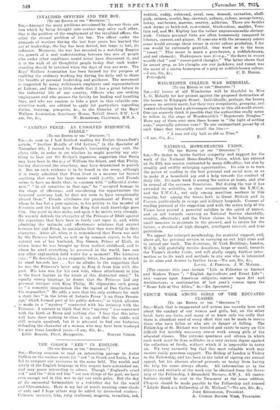THE COLOUR " RED " IN ENGLISH.
[To THE EDITOR OF THE " SPECTATOR."] SIR ,—Having occasion to read an interesting passage in Aulus Genius on the various words for " red " in Greek and Latin, I was led to compare our resources in the same field. The wealth and nicety of the English language in this respect have astonished me, and may prove interesting to others. Though "England's cruel red " and the " thin red line " are now things of the past, we have seen enough red in this war to dye our souls gules. But the day of its successful termination is a red-letter day for the world and Christendom. Here is my list of words meaning some shade of red; and I hope others may be added by interested readers : Crimson. carmine, lake, ruby (rubious), magenta, vermilion, red, reddish, ruddy, rubicund, coral, rose, damask, carnation, shell- pink, salmon, scarlet, bey, chestnut, auburn, rufous, orange-tawny, tawny, nut-brown, maroon, murrey, solferino. There are besides such terms as brick-red, rust-colour, blush-colour, madder, Vene- tian red, and Mr. Kipling has the rather unpronounceable shrimp- pink. Certain personal tints are often humorously compared to lobsters, carrots, and ginger. If some one with the necessary colour sense would arrange these terms in strict colour gradation, I for one would be extremely grateful. One word as to the term " russet." This seems to mean a grey-brown, a reddish-brown, and red (damask). Shakespeare uses it—e.g., " the dawn in russet mantle clad " and " russet-pated choughs." The latter shows that he meant grey, as his choughs are our jackdaws, and russet was the name of a coarse homespun of a grey or reddish-brown colour.


































 Previous page
Previous page